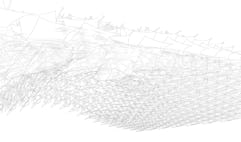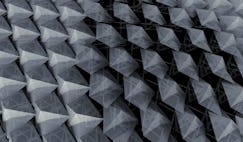The Stratus Project
responsive envelope system













The Stratus Project is an ongoing body of design research investigating the potential for kinetic, sensing and environment-responsive interior envelope systems. The research emerges from a consideration of our attunement to the soft systems of architecture – light, thermal gradients, air quality and noise – to develop and prototype envelopes that not only perform to affect these atmospheres, but also to promote continual information and material exchange, and eventually dialogue, between occupant and atmosphere. It deploys a distributed approach to structural, mechanical and communications systems design and delivery, where localized response to demand is prioritized. The project works to reclaim the environmentally performative elements of architecture – in this case, specifically, interior mechanical delivery and interface systems – to within the purview of the discipline, as territories of material, formal, technological and experiential innovation and exploration. The Stratus Project is funded through a University of Michigan Taubman College of Architecture and Urban Planning 2010 Research Through Making Grant, University of Michigan Office of the Vice President for Research 2010 Small Projects Grant and a Social Science and Humanities Research Council of Canada 2011 Research Creation Grant.
The first prototype mobilizes smart surfaces and responsive technologies in the development of a thick suspended ceiling that produces a light and air-based architectural environment using distributed technologies and systems to sense energy and movement flows, tempered by occupant-responsive feedback in producing envelopes of intimate and collective space.
On the underside of the structure are the “breathing cells”: individually actuated translucent cells that form a light-diffusing skin and that part like gills to allow thermal localized conditioning and air extraction. Physical presence of the breather, as well as environmental conditions such as temperature, light, carbon dioxide and airborne pollutants, are measured through a distributed network of sensors that communicate with actuators to trigger fans to locally supply or extract air, and lights to illuminate occupied space.
Stratus v1.0 prototype is comprised of a thickly arrayed suspended textile consisting of a three-dimensional networked structure that organizes and supports operational components. The structural foundation is a cable-strut tensegrity weave which is lightweight and stable, yet elastic and capable of deformation, allowing for controlled gross movement across all dimensions without failing or disturbing the attached components. Woven into the tensegrity mat is a distributed array of sensors, actuators, lights, micro-fans and diffusing thermally absorptive fabric panels.
Sensors detect temperature rise from baseline settings, they then communicate with actuator motors to rotate breathing cells to open, the cooling fans are then deployed.
The axonometric view of a 3-cell structure demonstrates reaction to temperature change; the plan view reveals the thick array of tensegrity structure, breathing cells, fabric membranes, sensors and actuators.
The flexible tensegrity structure allows for the surface to undulate and respond to occupant presence and local thermal demand.
ANSYS fluid dynamic modelling software Fluent was used to test the effects of various configurations of Stratus on air velocity, thermal stratification, and energy draw.
| Typology | Responsive Envelope System |
| Date | 2010 |
| Location | University of Michigan |
| scale | 80 sf full-scale prototype |
| scope | Design and prototyping of a kinetic, sensing, environment-responsive interior envelope system. Research includes lightweight deformable structures, distributed sensing and servo-mechanism driven actuation, micro-processing, cybernetic systems, machine learning and fabrication logics. |
project Team
| Leads | Kathy Velikov and Geoffrey Thün |
| Design research collaborators | Zain AbuSeir, Mary O’Malley Matt Peddie, Colin Ripley |
| Fabrication + Animation | F. Parke MacDowell |
| Programming + actuation | James Christian, Christopher Parker, Jason Prasad |
| Protoyping | Sara Dean, Jessica Mattson, Dan McTavish, Christopher Niswander, Lisa Sauvé, Adam Smith |
| Collaborators | Dr. Aline Cotel [Fluid Dynamics and Particle Image Velocimetry], Dr. Jerome Lynch [Embedded Sensing and Wireless Integrated Microsystem Integration], Dr. Lars Junghans [HVAC Consultant], Dr. Robert Dick [Distributed Sensing and Computation] |
AWARDS | GRANTS
- ACSA 2012 Faculty Design Award